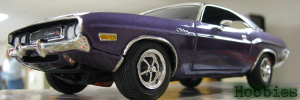















Collecting Model Cars And Its History |
|---|

|
Adriana Noton
SubmitYOURArticle.com
August 14, 2011
Miniature automobiles have been around almost as long as their larger counterparts. Since the early 1900's, manufacturers have been making models of vehicles. The early versions were made from iron. In the 30's and 40's miniature car production was changed to tin and steel. Cars, trucks and even military vehicles were made in this era. Collecting model cars became popular in the 60's when many precision miniature automobiles were made for adults.
In the United States toy automobiles were typically made of steel or plastic with little detail and no moving parts. Toys in Europe, on the other hand were cast in zinc or an alloy and made with precision detail. Such detail often included doors, trunks and hoods that opened.
In the 1950's in Europe, smaller scales like 1:43 or 1:64 became popular. Similar sized toys in the United States made by Dinky toys or Matchbox had no opening parts. Eventually though, quality and detail improved in the U. S. Market. Detail such as plastic windows, detailed interiors, separate wheels and axles, and even working suspensions were added to the vehicles.
Since the 1980's the model car market has focused on adult collectibles rather than on toys for children. During the 90's larger premium miniatures at hobby stores and toy stores became very popular. These models featured working parts and a high level of detail. Other replicas were produced all over the world with varying quality. As European companies finished marketing a particular model, the dies would be sold off, often to manufacturers in developing countries.
The collecting of miniature automobiles has been around as long as cars have. However, in the 90's collecting became more sophisticated, much more like stamp or coin collecting. Attention began to be paid to variations which led to rising values for the rare. Additionally at this time, Matchbox and other companies began making models specifically for the collector market.
Licensing, which hadn't really been attended to by the car manufacturers began to play a more important role as collecting became more sophisticated. Before the 1980's, car companies generally viewed the miniature replicas of their vehicles as free advertising. As they became more interested in retaining the rights for their designs, smaller toy makers were driven out of business by the high licensing fees.
Another segment of the collectors market developed around model assembly kits. Hobbyists, beginning the 1940's sought after detailed kits made of die-cast metal, resin or wood. As time went the popularity of this hobby waxed and waned. However in recent years, models of classic autos have been re-released following a resurgence in popularity after NASCAR began releasing racing car kits. Hobby magazines such as Scale Auto Enthusiast and Model Cars Magazine arose and solidified the collector community.
Modern versions of these scale automobile kits have taken advantage of technology and have included new levels of precision detail. Items such as foil for chrome trim, wiring for engines and aluminum parts have given these miniatures a true-to-life authenticity not possible before. The community has also leveraged technology to expand through websites and bulletin boards.
----------------------------------------------------
Check out DieCast cars Magazine for up to date assessments of diecast model car values. You may find this is better than buying gold.
http://www.diecastbymail.ca
